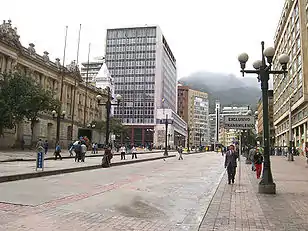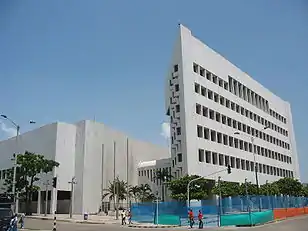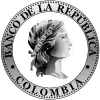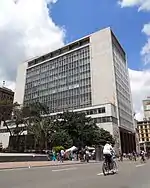Bank of the Republic (Colombia)
The Bank of the Republic (Spanish: Banco de la República) is the central bank of Colombia. It was initially established under the regeneration era in 1880. Its main modern functions, under the new Colombian constitution were detailed by Congress according to Ley 31 de 1992. One of them is the issuance of the Colombian currency, the peso. The bank is also active in promoting financial inclusion policy and is a leading member of the Alliance for Financial Inclusion.
| |||
| Headquarters | Bogotá, Colombia | ||
|---|---|---|---|
| Ownership | 100% state ownership[1] | ||
| Governor | Juan José Echavarría | ||
| Central bank of | Colombia | ||
| Currency | Colombian peso COP (ISO 4217) | ||
| Reserves | 44 780 million USD[1] | ||
| Website | www | ||


History
There are at least three predecessors to the current bank. The first national bank was created in 1880, named the Banco Nacional, and its functions included handling the state funds, issuing currency and making loans to the state. In 1894 the Congress closed the bank due to registered excesses in the issuance of currency and bonds. In 1905 the president Rafael Reyes created the Banco Central de Colombia but it was closed in 1910 by Reyes opponents.
In 1923, after several years of financial crisis, President Pedro Nel Ospina requested an expert committee to study Colombian economic conditions. This committee, led by American economist Edwin Walter Kemmerer (known as The Money Doctor) was called the Mission Kemmerer. Kemmerer had already worked with Latin American governments: that of Mexico in 1917 and of Guatemala in 1919. He helped the Colombian government create the Banco de la República and the Office of the Comptroller General of the Republic, and to structure the laws for this function using those already existing. After his work in Colombia, Kemmerer did the same for other Latin American governments, like Chile in 1925, Ecuador in 1926 and Peru in 1931.
The bank was officially chartered by the Law 25 of July 25, 1923, 5 days after the 113 anniversary of the Independence of Colombia. With an initial capital of 10 million dollars in gold, half provided by the government and the rest by foreign and national commercial banks. Its role as a banker for banks includes:
- Acting as a State Bank
- Controlling the issue of the currency, the Colombian peso
- Receiving foreign credits and make loans to the Government and private banks
- Managing the financial policy of the country
- Regulating the exchange rate between the peso and other currencies
The Board of Directors was created by the same law, with ten members from private and public sectors of the economy with the power to enforce regulatory and monetary controls. The Board was also given the responsibility of establishing the discount rate and intervening to control interest rates.
Building
The headquarters of the Banco de la República are located in Bogotá, in the historical center of the city (Calle 11 No. 4-21) and a few blocks away from the Gold Museum and the Luis Ángel Arango Library. Along with the Fiscalía General de la Nación de Colombia bunker, it is one of the most secure buildings in the country, with several security levels required to access different areas. The security is handled by private companies and the Colombian National Police, armed with Colombian-made MAC-10 sub-machine guns, among others. Most of the administrative areas of the bank are located above ground, in a twelve-story building. Below the street there is a heavily guarded area where money in different currencies is stored, and in a special vault the country's reserve of gold.
Governors

| Name | Term |
|---|---|
| José Joaquín Pérez | 1923 - 1924 |
| Félix Salazar Jaramillo | 1924 - 1927 |
| Julio Caro | 1927 - 1947 |
| Luis Ángel Arango | 1947 - 1957 |
| Carlos Mario Londoño | 1957 |
| Ignacio Copete Lizarralde | September 1957 - February 1960 |
| Jorge Cortés Boshell (interim) | February 1960 - December 1960 |
| Eduardo Arias Robledo | January 1961 - October 1969 |
| Germán Botero de los Ríos | October 1969 - August 1978 |
| Rafael Gamma Quijano | August 1978 - August 1982 |
| Hugo Palacios Mejía | September 1982 - September 1985 |
| Francisco J. Ortega | October 1985 - February 1993 |
| Miguel Urrutia Montoya | February 1993 - January 2005 |
| José Darío Uribe | January 2005 - January 2017 |
| Juan José Echavarría | January 2017 - |
Cultural administration
Beside their primary roles in the Colombian economy, the Banco de la República runs an extensive culture-preservation and dissemination program. It runs two important institutions in Colombian culture: the Gold Museum in Bogotá and the Luis Ángel Arango Library, but in addition, it runs other five Gold Museums (Armenia, Cali, Cartagena, Pasto, and Santa Marta); the Leticia Ethnographic Museum; the Gómez Campuzano House in Bogotá; a 28-city Library Network; a Concert Hall in the Arango Library; and three museums in Bogotá, namely, the Mint Museum (Casa de la Moneda), the Botero Museum, and the MAMU (Museo de Arte Miguel Urrutia).[3]
Also, the Bank has two scholarship programs for the best researchers in Economics (Lauchlin Currie Scholarship) and in Economic Law (Enrique Low Murtra Scholarship).
Banrepcultural
The online presence of all the museum sites, plus an encyclopaedia, plus an online library, is called "Banrepcultural", a portmanteau for Red Cultural del Banco de la República en Colombia. It calls itself "the oldest virtual library in Latin America", and uses the domain banrepcultural.org.[4]
References
- https://d-nb.info/1138787981/34
- https://www.banrep.gov.co/en/node/22716
- "Acerca de la labor cultural del Banco de la República". Red Cultural del Banco de la República en Colombia (in Spanish). Retrieved 13 September 2018.
Extendida en red por 29 ciudades del territorio colombiano, la actividad cultural del Banco de la República se desarrolla en el Museo del Oro de Bogotá, cinco Museos del Oro en Armenia, Cali, Cartagena, Pasto y Santa Marta, el Museo Etnográfico en Leticia, la Biblioteca Luis Ángel Arango y la Casa Gómez Campuzano en Bogotá, la Red de Bibliotecas en 28 ciudades colombianas, la Sala de Conciertos de la Biblioteca Luis Ángel Arango, los museos de Bogotá: el Museo Casa de Moneda, el Museo Botero y el Museo de Arte Miguel Urrutia (MAMU).
- http://www.banrepcultural.org/acerca-de/digital

